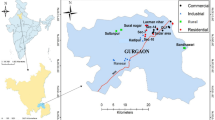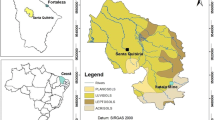Abstract
Multi-element mineralization of copper (Cu), gold (Au), and precious group of elements (PGEs) in the Kishapu-Igunga-Iramba areas in the central parts of Tanzania was evaluated in the study. The main aim was to characterize the mineralization with a focus on the pathfinder elements and the controls of the mineralization in the area through soil geochemistry and multivariate statistics and multivariate linear regression (MLR) methods. From the multivariate statistical methods applied, the Cu, Au, and PGEs mineralization in the area is associated with arsenic (As) and antimony (Sb). The Cu and Au occurrence in the area is a likely porphyry Cu-Au from their strong association. The mineralization (multi-elements) is strongly controlled by mafic–ultramafic rocks and volcaniclastics in the northern, southern, and central parts of the study area. From the MLR, Cu is strongly predicted by Zn, Ni, and Au with an error of ± 0.230, with Pd being predicted by only Pt and vice versa, with an error margin of ± 0.001. Au on the other hand is predicted by Cu, Fe, and Cr with an error margin of ± 0.473. The style of mineralization of these elements is comparable to their occurrence in the Neoproterozoic setting and the Paleoproterozoic Ubendian belt of Tanzania as well as the PGEs occurrence in South Africa and Canada. Coupling MLR with hierarchical cluster analysis and factor analysis brings out a more definitive elemental association to precious minerals occurrence from the study and is strongly recommended.






Similar content being viewed by others
Data availability
Not applicable.
Code availability
Not applicable.
References
Abu M, Kalimenze J, Mvile BN, Kazapoe RW (2021) Sources and pollution assessment of trace elements in soils of the central, Dodoma region, East Africa: implication for public health monitoring. Environ Technol Innov 23:101705
Aitchison J (1986) The statistical analysis of compositional data. Chapman & Hall, London (416 pp)
Barnes SJ, Mole DR, Hornsey R, Schoneveld LE (2019) Nickel-copper sulfide mineralization in the Ntaka Hill ultramafic complex, Nachingwea region, Tanzania. Econ Geol 114(6):1135–1158
Borg G (1994) The Geita gold deposit in NW Tanzania—geology, ore petrology, geochemistry and timing of events. Geologisches Jahrbuch D 100:545–595
Cabri LJ, Wilhelmij HR, Eksteen JJ (2017) Contrasting mineralogical and processing potential of two mineralization types in the platinum group element and Ni-bearing Kapalagulu Intrusion, western Tanzania. Ore Geol Rev 90:772–789
Carranza EJM (2011) Analysis and mapping of geochemical anomalies using log ratio-transformed stream sediment data with censored values. J Geochem Explor 110(2):167–185
Djon MLN, Barnes S-J (2012) Changes in sulphides and platinum-group minerals with the degree of alteration in the Roby, Twilight, and High-Grade Zones of the Lac des Iles Complex, Ontario, Canada. Mineral Deposita 47:875–896
Dunn SC, Bjorn P, Steele-MacInnis M, Kramers JD, Pierre BS, Erasmus R, Harris C (2021) Neoproterozoic copper-gold mineralization in the Amani area, southwestern Tanzania. Ore Geol Rev 132:104070
Dunn SC, Bjorn P, von der Heyden (2022) Proterozoic – Paleozoic orogenic gold mineralization along the southwestern margin of the Tanzania Craton: a review. Afr Earth Sci 185:104400. https://doi.org/10.1016/j.jafrearsci.2021.104400
Duran CJ, Hugo D, Philippe P, Sarah-JB, Martin R, Dany S, Ben JC, Jean-Philippe A, Eduardo TM (2018) Applications of trace element chemistry of pyrite and chalcopyrite in glacial sediments to mineral exploration targeting: example from the Churchill Province, northern Quebec, Canada. Gexplo (2018). https://doi.org/10.1016/j.gexplo.2018.10.006
Egozcue JJ, Pawlowsky-Glahn V, Mateu-Figueras G, Barcelo-Vidal C (2003) Isometric logratio transformations for compositional data analysis. Math Geol 35(3):279–330
Evans DM, Barrett FM, Prichard HM, Fisher PC (2012) Platinum–palladium–gold mineralization in the Nkenja mafic–ultramafic body, Ubendian metamorphic belt, Tanzania. Mineralium Deposita 47(1):175–196
Evans DM, Hunt JPPM, Simmonds JR (2016) An overview of nickel mineralisation in Africa with emphasis on the Mesoproterozoic East African Nickel Belt (EANB). Episodes Journal of International Geoscience 39(2):318–333
Grunsky EC, Mueller UA, Corrigan D (2014) A study of the lake sediment geochemistry of the Melville Peninsula using multivariate methods: applications for predictive geological mapping. J Geochem Explor 141:15–41
Henckel J, Poulsen KH, Sharp T, Spora P (2016) Lake victoria goldfields. Episodes Journal of International Geoscience 39(2):135–154
Kabete JM, Groves DI, McNaughton NJ, Mruma AH (2012) A new tectonic and temporal framework for the Tanzanian Shield: implications for gold metallogeny and undiscovered endowment. Ore Geol Rev 48:88–124
Kitco Education (2020) Largest Gold Mines in Africa: Q1 2020 Overview. https://education.kitco.com/precious-metals/largest-gold-mines-africa-q1-2020-overview. Accessed 27 July 2022
Koegelenberg C, Kisters AFM, Kramers JD, Frei D (2015) U-Pb detrital zircon and 39Ar–40Ar muscovite ages from the eastern parts of the Karagwe-Ankole Belt: tracking Paleoproterozoic basin formation and Mesoproterozoic crustal amalgamation along the western margin of the Tanzania Craton. Precambr Res 269:147–161
Kwelwa SD, Dirks PH, Sanislav IV, Blenkinsop T, Kolling SL (2018) Archaean gold mineralization in an extensional setting: the structural history of the Kukuluma and Matandani Deposits, Geita Greenstone Belt, Tanzania. Minerals 8(4):171
Kyser K, Barr J, Ihlenfeld C (2015) Applied geochemistry in mineral exploration and mining. Elements 11(4):241–246
Lawley CJM, Selby D, Condon D, Imber J (2014) Palaeoproterozoic orogenic gold style mineralization at the Southwestern Archaean Tanzanian cratonic margin, Lupa Goldfield, SW Tanzania: implications from U-Pb titanite geochronology. Gondwana Res 26(3–4):1141–1158
Liu B, Diao G, Han X et al (2015) Spatial distribution and ecological risk assessment of heavy metals in surface sediments from Songhua River. Science Technology and Engineering 15(8):140–145
Liu Y, Carranza EJM, Zhou K, Xia Q (2019) Compositional balance analysis: an elegant method of geochemical pattern recognition and anomaly mapping for mineral exploration. Nat Resour Res 28(4):1269–1283
Manya S (2012) SHRIMP zircon U-Pb dating of the mafic and felsic intrusive rocks of the Saza area in the Lupa goldfields, southwestern Tanzania: Implication for gold mineralization
Mvile BN, Abu M, Kalimenze J (2021) Trace elements geochemistry of in situ regolith materials and their implication on gold mineralization and exploration targeting, Dodoma Region, East Africa. Mining, Metallurgy & Exploration 38(5):2075–2087
Nude PM, Asigri JM, Yidana SM, Arhin E, Foli G, Kutu JM (2012) Identifying pathfinder elements for gold in multi-element soil geochemical data from the WaLawra belt, northwest Ghana: a multivariate statistical approach. Int J Geosci 3(01):62
Otero N, Tolosana-Delgado R, Soler A, Pawlowsky-Glahn V, Canals A (2005) Relative vs absolute statistical analysis of compositions: a comparative study of surface waters of a Mediterranean river. Water Res 39(7):1404–1414
Piña R, Gervilla F, Barnes S-J, Oberthür T, Lunar R (2016) Platinum-group element concentrations in pyrite from the Main Sulfide Zone of the Great Dyke of Zimbabwe. Mineral Deposita 51:853–852
Sadeghi M, Billay A, Carranza EJM (2015) Analysis and mapping of soil geochemical anomalies: implications for bedrock mapping and gold exploration in Giyani area, South Africa. J Geochem Explor 154:180–193
Sadeghi M, Morris GA, Carranza EJM, Ladenberger A, Andersson M (2013) Rare earth element distribution and mineralization in Sweden: an application of principal component analysis of OREGS soil geochemistry. in: Foley N, DeVivo B, Salminen R (GuestEds.) Rare earth elements:the role of geology, exploration, and analytical geochemistry in ensuring diverse sources of supply and a globally sustainable resource. Special Issue. J Geochem Explor 133:160–175
Sakyi PA, Manu J, Su BX, Kwayisi D, Nude PM, Dampare SB (2019) Geochemical and Sm–Nd isotopic evidence for the composition of the Palaeoproterozoic crust of the West African Craton in Ghana. Geol J 54(6):3940–3957
Salminen R, Kashabano J, Myumbilwa Y, Petro FN, Partanen M (2008) Indications of deposits of gold and platinum group elements from a regional geochemical stream sediment survey in NW Tanzania. Geochemistry: Exploration, Environment, Analysis 8(3–4):313–322
Sanislav IV, Brayshaw M, Kolling SL, Dirks PHGM, Cook YA, Blenkinsop TG (2017) The structural history and mineralization controls of the world-class Geita Hill gold deposit, Geita Greenstone Belt, Tanzania. Mineralium Deposita 52(2):257–279
Sanislav IV, Dirks PHGM, Blenkinsop T, Kolling SL (2018) The tectonic history of a crustal-scale shear zone in the Tanzania Craton from the Geita Greenstone Belt, NW-Tanzania Craton. Precambr Res 310:1–16
Schmidbaur H, Cihonski JL (2003) Encyclopedia of physical science and technology || Noble Metals (Chemistry). ():463–492
Sunkari ED, Appiah-Twum M, Lermi A (2019) Spatial distribution and trace element geochemistry of laterites in Kunche area: implication for gold exploration targets in NW, Ghana. J Afr Earth Sci 158:103519
Taylor S, McLennan SM (1985) The continental crust: its composition and evolution
van Straaten HP (1984) Gold mineralization in Tanzania – a review. In: Foster RP (ed) Gold ’82: The geology, geochemistry and genesis of gold deposits: Rotterdam. Balkema, A.A., pp 673–685
Vos IMA, Bierlein FP, Standing JS, Davidson G (2009) The geology and mineralisation at the Golden Pride gold deposit, Nzega Greenstone Belt, Tanzania. Miner Deposita 44:751–764. https://doi.org/10.1007/s00126-009-0245-3
World Gold Council (2022) Global mine production by country. https://www.gold.org/goldhub/data/gold-production-by-country. Accessed 27 July 2022
Wu J, Li P, Wang D, Ren X, Wei M (2019) Statistical and multivariate statistical techniques to trace the sources and affecting factors of groundwater pollution in a rapidly growing City on the Chinese Loess Plateau. Human and Ecological Risk Assessment: An International Journal
Acknowledgements
The authors are thankful to the Geological Survey of Tanzania (GST) for providing all data used in this work.
Author information
Authors and Affiliations
Corresponding author
Ethics declarations
Conflict of interest
The authors declare no competing interests.
Additional information
Responsible Editor: Domenico M. Doronzo
Rights and permissions
Springer Nature or its licensor (e.g. a society or other partner) holds exclusive rights to this article under a publishing agreement with the author(s) or other rightsholder(s); author self-archiving of the accepted manuscript version of this article is solely governed by the terms of such publishing agreement and applicable law.
About this article
Cite this article
Kalimenze, J.D., Abu, M. & Mvile, B.N. Soil geochemistry and multivariate statistical assessment of Copper–Gold-PGEs mineralization in parts of Singida Region of the Tanzania Craton, Tanzania, East Africa. Arab J Geosci 16, 59 (2023). https://doi.org/10.1007/s12517-022-11148-5
Received:
Accepted:
Published:
DOI: https://doi.org/10.1007/s12517-022-11148-5




